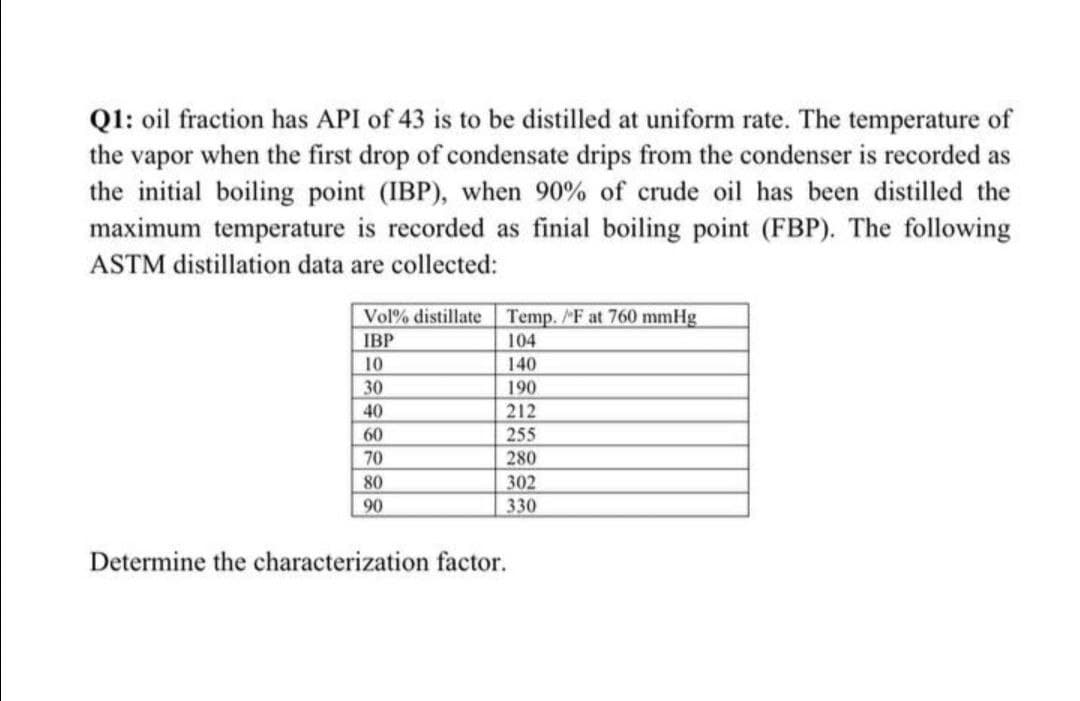Ql: oil fraction has API of 43 is to be distilled at uniform rate. The temperature of the vapor when the first drop of condensate drips from the condenser is recorded as the initial boiling point (IBP), when 90% of crude oil has been distilled the maximum temperature is recorded as finial boiling point (FBP). The following ASTM distillation data are collected: Vol% distillate Temp. MF at 760 mmHg IBP 104 10 140 30 190 40 212 60 255 70 280 80 302 90 330 Determine the characterization factor.
Ql: oil fraction has API of 43 is to be distilled at uniform rate. The temperature of the vapor when the first drop of condensate drips from the condenser is recorded as the initial boiling point (IBP), when 90% of crude oil has been distilled the maximum temperature is recorded as finial boiling point (FBP). The following ASTM distillation data are collected: Vol% distillate Temp. MF at 760 mmHg IBP 104 10 140 30 190 40 212 60 255 70 280 80 302 90 330 Determine the characterization factor.
Introduction to Chemical Engineering Thermodynamics
8th Edition
ISBN:9781259696527
Author:J.M. Smith Termodinamica en ingenieria quimica, Hendrick C Van Ness, Michael Abbott, Mark Swihart
Publisher:J.M. Smith Termodinamica en ingenieria quimica, Hendrick C Van Ness, Michael Abbott, Mark Swihart
Chapter1: Introduction
Section: Chapter Questions
Problem 1.1P
Related questions
Question

Transcribed Image Text:Ql: oil fraction has API of 43 is to be distilled at uniform rate. The temperature of
the vapor when the first drop of condensate drips from the condenser is recorded as
the initial boiling point (IBP), when 90% of crude oil has been distilled the
maximum temperature is recorded as finial boiling point (FBP). The following
ASTM distillation data are collected:
Temp. F at 760 mmHg
104
Vol% distillate
IBP
10
140
30
190
40
212
60
255
70
280
80
302
90
330
Determine the characterization factor.
Expert Solution
This question has been solved!
Explore an expertly crafted, step-by-step solution for a thorough understanding of key concepts.
Step by step
Solved in 3 steps

Knowledge Booster
Learn more about
Need a deep-dive on the concept behind this application? Look no further. Learn more about this topic, chemical-engineering and related others by exploring similar questions and additional content below.Recommended textbooks for you

Introduction to Chemical Engineering Thermodynami…
Chemical Engineering
ISBN:
9781259696527
Author:
J.M. Smith Termodinamica en ingenieria quimica, Hendrick C Van Ness, Michael Abbott, Mark Swihart
Publisher:
McGraw-Hill Education

Elementary Principles of Chemical Processes, Bind…
Chemical Engineering
ISBN:
9781118431221
Author:
Richard M. Felder, Ronald W. Rousseau, Lisa G. Bullard
Publisher:
WILEY

Elements of Chemical Reaction Engineering (5th Ed…
Chemical Engineering
ISBN:
9780133887518
Author:
H. Scott Fogler
Publisher:
Prentice Hall

Introduction to Chemical Engineering Thermodynami…
Chemical Engineering
ISBN:
9781259696527
Author:
J.M. Smith Termodinamica en ingenieria quimica, Hendrick C Van Ness, Michael Abbott, Mark Swihart
Publisher:
McGraw-Hill Education

Elementary Principles of Chemical Processes, Bind…
Chemical Engineering
ISBN:
9781118431221
Author:
Richard M. Felder, Ronald W. Rousseau, Lisa G. Bullard
Publisher:
WILEY

Elements of Chemical Reaction Engineering (5th Ed…
Chemical Engineering
ISBN:
9780133887518
Author:
H. Scott Fogler
Publisher:
Prentice Hall


Industrial Plastics: Theory and Applications
Chemical Engineering
ISBN:
9781285061238
Author:
Lokensgard, Erik
Publisher:
Delmar Cengage Learning

Unit Operations of Chemical Engineering
Chemical Engineering
ISBN:
9780072848236
Author:
Warren McCabe, Julian C. Smith, Peter Harriott
Publisher:
McGraw-Hill Companies, The